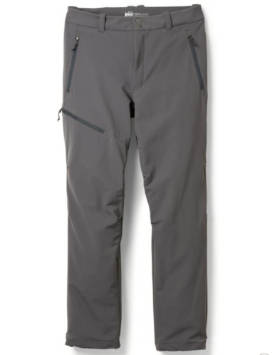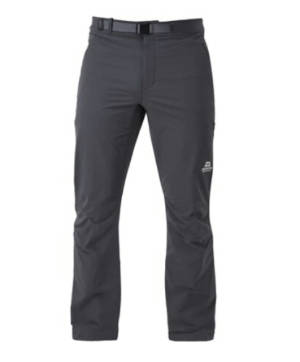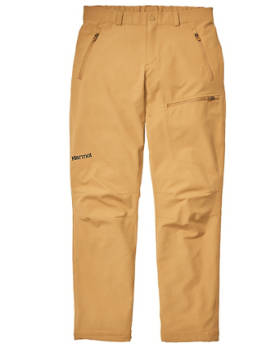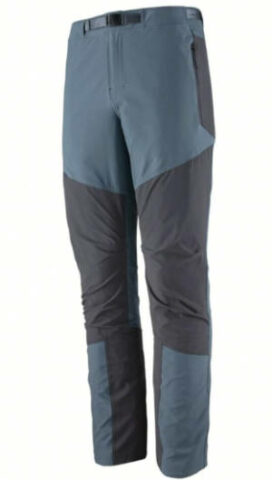
The best winter hiking pants are highly breathable softshell pants that prevent the accumulation of perspiration when hiking, snowshoeing, climbing/mountaineering, or even ski touring in winter. They’re made with woven nylon or polyester that is warmer and more windproof than normal three-season hiking pants and are treated with an exterior DWR coating to help them repel water. Many softshell pants have features that can be used for multiple winter sports while others are more hiking-specific. The fit also varies by activity: climbing-style pants tend to run slim while pants that are good for hiking/snowshoeing are roomier and more easily layered. Popular features include a buried/integrated belt providing for hipbelt and climbing harness compatibility, zippered side vents, zippered pockets, and ankle adjustability. Be sure to read our FAQ below about how to choose the best softshell winter pants for your needs.
Here are the 10 best softshell winter hiking pants that we recommend.
1. REI Activator 3.0 Softshell Pants
The REI Activator 3.0 is a softshell pant with a gusseted crotch, moderate stretchiness, and three zippered pockets. It has a good balance between breathability and warmth and is coated with an external DWR to prevent blowing snow from making the pants wet. It requires an external belt (previous models had an integrated buried belt). Despite its relative lack of technical features, they’re a winter hiker favorite, very durable and long-lasting, and quite affordable.
A women’s model is also available. Read our REI Activator 3.0 Pant review. These pants are my favorites and have been for close to 10 years. They breathe well, they’re not too warm to hike in, and they’re relatively inexpensive. View at REI2. KUHL Klash Pants
KUHL’s Klash Pants are durable softshell pants with a roomy fit that is perfect for winter hiking and snowshoeing. They provide excellent freedom of movement, they dry quickly when they get wet, and have lots of pockets so you can stay organized. They have belt loops with an Ultrasuede waistband for a comfortable fit, a gusseted crotch, and articulated knees. The pants have a zippered bottom hem gusset to fit over boots, hooks that can be used instead of gaiters to help seal out the cold, and ankle cuff guards to protect against abrasion.
A women’s model is also available. Read our Kuhl Klash Pant review.
These pants are quite comfortable and can serve double duty for cross-country skiing and other winter sports. View at REI3. Arc’teryx Gamma Soft-Shell Pants
The Arc’tyeryx Gamma Pant is a wind-resistant softshell pant with a durable water repellent finish to fend off moisture and a brushed inner face for thermal comfort. They have an integrated, buried belt for climbing harness compatibility with a micro-fleece waistband for comfort. There are three zippered pockets: one thigh pocket and two handwarmer pockets. A gusseted crotch and articulated knees and seat provide excellent freedom of movement while adjustable ankle cuffs and lace hooks provide good boot integration.
A women’s model is also available, but is called the Gamma LT. These stretchy pants have a buried belt that’s harness-compatible and hipbelt-friendly. While they are lightweight, they are warm enough for snowshoeing, but can also be layered with long underwear or rain pants for more warmth. View at REI4. Mountain Equipment Ibex and Chamois Pants
Mountain Equipment
Men’s Ibex Pants and their counterpart the
Women’s Chamois Pants are double woven softshell pants that provide extra warmth and excellent durability. They are loaded with five zippered pockets: two side pockets, one rear, and two thigh pockets. They have an integrated buried belt with a microfleece waistband for added comfort with gusseted ankle zips which are also large enough to fit around ski boots.
See the SectionHiker review.
These are great pants that are roomy, with a buried belt that works well with a backpack hip belt, and lots of pockets. 5. Mountain Hardwear Chockstone Alpine Pants
Mountain Hardwear’s Chockstone Alpine Pants are made with a double-weave four-way stretch fabric with a DWR coating for water resistance. They have a buried integrated belt for hipbelt and climbing harness compatibility and have two zippered pockets, one on the thigh and one in the rear. The ankles also have adjustable cuffs that fit over boots to keep out rocks, ice, and snow. The fit is slim.
A women’s model is also available. These pants are great for multi-sport use including ice climbing, cross-country skiing, and winter hiking. The built-in stretch provides an excellent range of motion for your legs, as well as warmth and wind protection. View at Moosejaw6. Rab Ascendor AS Soft-Shell Pants
Rab’s Ascendor AS Softshell Pant is a midweight softshell pant with double weave outer fabric and soft with a soft brushed back for comfort with a fluorocarbon-free DWR for water repellency. It has four zippered pockets, including two mesh-lined pockets in front, one in the back, and one on the thigh. The pants have a fleece-lined waistband with a double snap closure and YKK zip fly, knee articulation for ease of movement, and a long-length gusset at the crotch for increased mobility. The pants have tapered legs good for crampon use, with adjustable width ankle cuffs and zippers to accommodate different types of footwear. Belt and brace loops are included..
A women’s model is also available.
These are versatile pants that are warm, breathable, and have an excellent range of motion for multi-sport use. View at REI7. Marmot Scree Soft Shell Pants
Marmot’s Scree Pants are durable and breathable softshell pants for winter hiking and snowsports. They have belt loops and a relaxed fit so they can be worn over a baselayer. The pants come with three climbing harness-compatible front pockets: a zippered thigh pocket and two front pockets made with mesh lining that lay flat and don’t bulk up. However, the pockets on the men’s model are substantially larger than the ones offered for women. Finally, shock cord adjustable ankle openings let you adapt to different boots.
A women’s model is also available.
Read our Marmot Scree Pant review. The Scree Pants are a solid value and are roomy enough to wear over long underwear if you run cold. View at Backcountry8. Outdoor Research Cirque II Softshell Pants
Outdoor Research’s Cirque II Softshell Pants are serious softshell pants for winter hiking, backpacking, mountaineering, and ski touring. They’re made with a 90d, double-weave fabric that is highly durable and warm with a gusseted crotch, articulated kneed, and plenty of stretch for big moves. The fleece-lined waistband has hook & loop side tabs to dial in a perfect fit and is suspender compatible (suspenders not included). There’s a thigh pocket, two handwarmer pockets, and an avalanche beacon pocket. Ankle scuff guards, zippers, drawcord cuff adjustment, and lace hooks are all included.
A women’s model is also available. The Cirque II is an excellent multi-sport option if you want one pair of pants that can span winter hiking and ski touring. Make sure you like the fit. View at REI9. Patagonia Terravia Alpine Pants
Patagonia Terravia Alpine Pants are softshell pants that come with a partially buried belt that is compfortable under a hip belt or climbing harness. They’re made with recycled polyester with a PFC-Free DWR coating to resist moisture. A gusseted crotch provides freedom of movement and slim legs let you see your feet. They have four mesh-lined zippered pockets; two hip pockets, one in the back and one on the thigh. Scuff panels protect inner legs from abrasion and wear and tear, while the cuffs adjust with a low-profile shockcord and cordlock ensuring compatibility with different footwear.
A women’s model is also available. These pants have a lot of stretch and slim legs so you can see your feet, which is important when wearing crampons. View at Patagonia10. Norrona Falketind Flex1 Pants
Norrona’s Falketind Flex1 softshell pants are well-suited for all-season trekking in the alpine. The pants are soft and stretchable providing good wind resistance and water repellency. They have a custom-fit waist system with velcro side tabs in addition to belt loops, a gusseted crotch, mesh-lined ventilation from the hips to the knee, two hand pockets, a back pocket, and a thigh pocket – all with zippers.
A women’s model is also available. If you run cold, the pants can be worn with a baselayer.
Read our review.
The velcro side tabs help dial in the fit, the fabric is wind resistant, and the side vents are great for aerobic activities such as cross-country skiing and snowshoeing. View at MoosejawSoftshell Winter Hiking Pants – FAQ
What are the best winter hiking pants?
Many experienced winter hikers prefer softshell winter pants because they’re simpler to use than wearing rain pants over a pair of long underwear. Softshell pants are also more form-fitting and don’t make any noise. The problem with rain pants and long underwear is that it can be difficult to vent your rain pants or take off your long underwear without first removing your rain pants and boots. Softshell pants are breathable enough, meaning that your sweat will evaporate through them if you start to warm up and perspire.
Are softshell pants good for snow?
Softshell pants are good for snow because they have a DWR coating on the exterior that repels water and they’re highly breathable so you don’t overheat. Hiking in snow or snowshoeing requires a lot of energy and it’s easy to overheat and perspire. You want to avoid getting too warm and sweating because it will wet your clothing and reduce its ability to insulate you.
Are softshell pants waterproof?
Softshell pants are far more breathable than the waterproof rain pants that some hikers wear, so you’ll stay cooler and perspire less when working hard when hiking up mountains or snowshoeing. While they have an external DWR repellent coating for enhanced rain resistance, they are not waterproof or as windproof as hard shell rain pants. We recommend carrying both softshell pants and rain pants on cold-weather hikes, the latter for rain and wind protection, as well as added warmth when layered over the softshell pants.
Are softshell pants windproof?
Softshell pants are more windproof and warmer than regular hiking pants, but they’re designed to be highly breathable and let some wind through. If you need protection from the wind, we’d recommend layering a pair of wind pants or rain pants over a pair of softshell pants when you need added wind protection.
Should you wear a baselayer under softshell pants?
You can wear a baselayer (long underwear) under softshell pants, but it’s often not necessary except on extremely cold days. Softshell pants are warmer than regular hiking pants and usually sufficient to keep you warm when you’re actively hiking or snowshoeing. If you need additional warmth because you’re being chilled by the wind or because you’re standing still and not moving and generating heat, you can warm up by wearing a pair of rain pants over your softshell pants. Also, if you wear a baselayer under softshell pants and find yourself overheating, it’s very difficult to delayer without taking off your boots and pants, unless your baselayer long underwear has side zips and is removable without requiring that you get undressed.
How are softshell hiking pants different from ski pants?
Ski pants are usually much heavier, bulkier, and warmer since there is so much start and stop activity involved especially if you’re skiing at a resort with chair lifts. many ski pants also have internal gaiters which are hot and awkward to use when hiking and snowshoeing.
Why do softshell pants have a buried or integrated belt?
A buried or integrated pants belt loops around your waist like a regular belt but is covered with fabric around the back and sides of the pant. This makes the belt compatible with a climbing harness or a backpack hipbelt. When climbing higher mountains, you may be required to rope-in with a climbing harness.
Why do softshell pants have zippered pockets?
Softshell pants have zippered pockets that are usually located in front of the pants and are positioned so they can be easily accessed even if you’re wearing a climbing harness. Zippered pockets are more streamlined than regular pockets and less likely to interfere with gear hanging from a climbing harness.
Why do some softshell pants have ankle cuffs?
Some softshell pants have a built-in ankle cuff on the inside of the legs to provide crampon protection when climbing, backcountry skiing, or winter hiking. The ankle cuff isn’t as substantial as a high gaiter and doesn’t replace wearing them, but can be a useful convenience for winter use, especially if you want to use the same pants for ski touring.
Why do softshell pants have articulated knees?
Articulated knees are baggier than the knees in regular pants and provide more freedom of movement especially for climbing.
What are gusseted softshell pants?
Gussetted pants have added fabric panels, usually triangular, that add more width to the crotch, making it easier to raise your knee when taking large steps or climbing vertical surfaces.
SectionHiker is reader-supported. We only make money if you purchase a product through our affiliate links. Help us continue to test and write unsponsored and independent gear reviews, beginner FAQs, and free hiking guides.
 SectionHiker.com Backpacking Gear Reviews and FAQs
SectionHiker.com Backpacking Gear Reviews and FAQs 









I’ve been seeing good comments in the cross country ski crowd and mountain bike crowd about Pearl Izumi Summit AmFIB Lite Pants and I see their warmest are the Summit AmFIB Alpha. I fall hike, bike, winter snowshoe, cross country ski and hike. I like Rab products for the fit and fabric finish. I bought some Incline VRs as an activity pant and daily wear this winter. I live in a Colorado mountain resort town and will get out almost every day. Last year I bought Incline AS which are close to the discontinued Vectors, a great pant. I do have some Craft XC ski pants but it is easy to slip on some base layers to head out to any ski course or trail in any of these pants for quick activity. It looks like the AmFIBs would do the same in a contoured fit for the bike and skiing.
Any thoughts on the Fjallraven Vida Pro pants for winter hiking? Always appreciate your insights.
Pretty sure they’re made of cotton. I wouldn’t be caught dead in them even if they’re covered in wax (which you need to apply and which washes out).
Actually, sounds like you might be caught dead in them if you wore them in winter. Thanks for the reply!
Keb Agile Winter Trousers are the best winter hiking trouser from Fjallraven, hands down. They’re new this year and should definitely be on this list. Lots of people try the Vidas because they’re relatively cheap, but they’re the least capable of the pants they offer, and offer less performance and more in terms of durability.
I *really* like my old pair of MH Cirque pants. They have lasted several seasons. I appreciate the warmth and durability, and the fit works for my skinny/athletic body; I don’t use the suspender attachments. Also, I was gifted a pair of Arcteryx Gamma pants that I returned for a pair of Patagonia Alpine Guide pants. The Patagonia’s are not as thick as the Cirque’s but have some stretch and seem durable enough. The Gamma’s felt quite lightweight, so I was happy to trade. (My use is Colorado, often hiking, snowshoeing, and climbing above tree line, so it’s useful to have patches for boots/crampons and lace hooks.)
*Outdor Research Cirque (not MH)
Good list. Unfortunately only one with side ventilation. I haven’t found REI Activators breathable. Had the V2 but apparently they haven’t added the feature to V3 either. Ok for a narrow temperature range if not doing high exertion.
Mine REI Activators are quite breathable and I wear them for hiking and XC which generates plenty of heat!